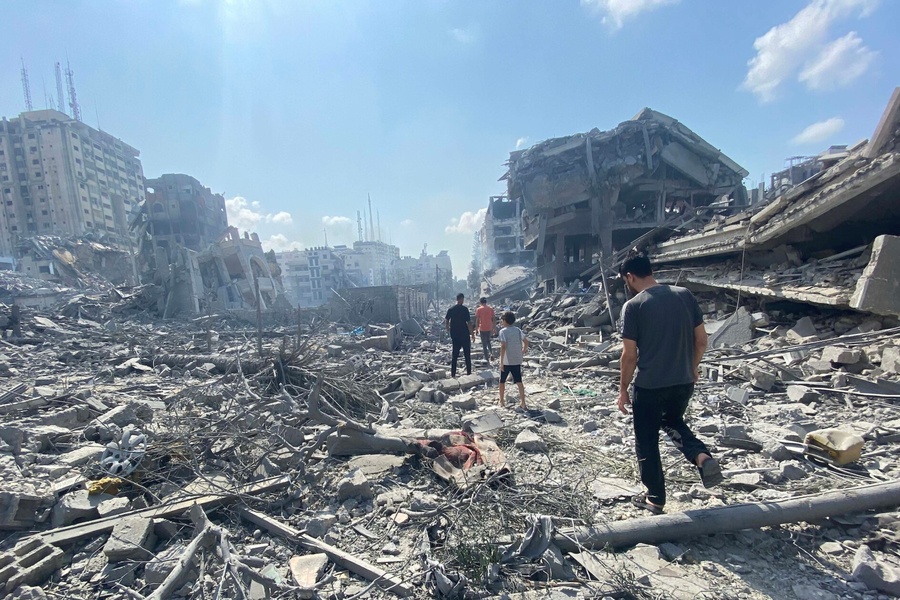Southwest Syria Braces for New Regime Offensive
Erdogan Secures the Powerful Presidency He Wanted
Published by The Lawfare Institute
in Cooperation With

Erdogan Secures the Powerful Presidency He Wanted
Turkish President Recep Tayyip Erdogan’s decision to call snap elections paid off at the polls this past Sunday. Preliminary results show him receiving the majority necessary to avoid a run-off and secure a new five-year term with the expanded executive powers he advocated and that were approved in a national referendum last year. Despite a groundswell of support pulled together in a brief campaign season that culminated in a rally in Istanbul attended by hundreds of thousands of people, the leading opposition candidate, Muharrem Ince of the People’s Republican Party (CHP), netted only 30 percent of the vote. But after two years of purges that have jailed politicians and political dissidents and left the Turkish government in control of most of the country’s media outlets, opposition candidates never had a fair chance.
Nearly 90 percent of Turkey’s eligible voters cast ballots in the election, which included races for president and parliament. Erdogan received a commanding 52.5 percent of the vote for president, but his party, the Justice and Development Party (AKP), did not perform as well and won 295 seats in parliament—six short of a majority. The AKP’s parliamentary ally, the Nationalist Action Party (MHP) won 49 seats, though, more than making up the difference. In the parliamentary opposition will be the CHP, the Iyi Party (a new liberal-secularist party), and the People’s Democratic Party (HDP), a pro-Kurdish party that crossed the 10-percent threshold to win 67 seats, despite its leadership having been arrested since the last election.
The deck was stacked against the opposition. The state of emergency put into effect after the coup attempt two years ago remains in place and has resulted in the arrests of nearly 80,000 people, including the leaders of the HDP. One of the party’s leaders, Selahattin Demirtas, ran for president from prison (placing third with 8.3 percent of the vote). With Erdogan’s government now firmly in control of much of Turkey’s media, Ince and Demirtas struggled to connect with the public. No televised debates were held, and Al-Monitor reports that Erdogan’s campaign received 181 hours of airtime on state television while Ince received just 15 hours of coverage.
Some irregularities were reported. Election observers from the OSCE said the imbalance in campaign exposure would hinder voters ability to make an informed choice. HDP officials have referred reports of bloc voting and voter intimidation by armed groups in the country’s restive southeast to the High Electoral Board for further review. Analysts have also noted that the MHP far outperformed polling that suggested it would fall short of the 10-percent threshold to win seats in the parliament. The election was also marred by violence: A local party official for the Iyi Party was gunned down on election day in Erzurum Province in eastern Turkey. A local CHP official said the attack was part of an altercation with representatives of the Interior Ministry and AKP sent to the province.
For now, though, Erdogan has secured the presidency he has long coveted. He assumes his expanded powers at a moment of crisis: The Turkish economy is teetering and its currency is dropping fast, and Erdogan’s confrontational nationalist-authoritarian turn has strained relationships with the United States and Europe. At an EU ministerial meeting on Monday, European diplomats called on Erdogan to take the occasion of his victory to end the country’s emergency law. As Brookings’ Kemal Kirisci writes, “it is difficult to see how Turkey can manage the geopolitical challenges in its region, emanating largely from the actions of Iran and Russia, without reforming its foreign policy.” And now, with no prime minister and greater executive authority, Erdogan will find it harder than ever to find partners to share the blame when his policies fail. “Even strongmen need scapegoats,” the Financial Times observes in an editorial. “Mr. Erdogan will shoulder the blame alone when things go wrong and there is much on the horizon that could turn nasty.”
Assad Regime Advances South Toward Jordanian Border
The Assad regime, having consolidated its control around Damascus and Aleppo, is now pressing its advantage south towards the border with Jordan and the Golan Heights. The new offensive undermines a ceasefire that has held for nearly a year as part of a de-escalation zone agreement reached between Russia, the United States, and Jordan. Southwest Syria is one of the last enclaves of the Free Syrian Army (FSA), but with the civil war in a late stage and the FSA’s one-time patrons have moved on to other priorities. With conflict escalating, both the United States and Jordan made clear this week that they would not be providing significant support.
Regime troops engaged in a series of sporadic skirmishes with rebel forces last week while sending reinforcements to Deraa, including elite forces that participated in the government’s capture of Eastern Ghouta. As International Crisis Group’s Sam Heller notes, by redeploying these Syrian troops to the south, the regime is avoiding sending in Iranian or Hezbollah forces that could risk an Israeli response. By the end of the weekend, state media was reporting that the regime was in control the villages northeast of the city and proceeding south with the goal of seizing the Syria-Jordan border.
The regime’s advance is driving a wave of refugees ahead of it. IRIN News reports that 25,000 displaced people have surged toward the Jordanian border since June 16, and the United Nations is concerned that the number could grow to as many as 200,000. The Jordanian government, reeling from recent economic protests, said this week that it cannot accept additional refugees from its wartorn neighbor. Jordan is currently hosting 660,000 registered Syrian refugees, but officials say the actual figure is much greater and it has had to close its northern border. This has led to the formation of a desolate camp of 50,000 refugees with limited access to aid that has coalesced along the sand berm at the border; U.N. officials worry that the new surge of displaced persons could result in another berm encampment.
The United States made clear to rebels that it would not be springing to their aid. According to a message seen by Reuters, U.S. defense planners told rebels that "you should not base your decisions on the assumption or expectation of a military intervention by us.” In a statement last week, the State Department warned of “serious repercussions” for breaching the de-escalation agreement, and said that Secretary of State Mike Pompeo had told Russian Foreign Minister Sergey Lavrov that “unilateral activity by the Assad regime or Russia” was “unacceptable.” What those repercussions might be, though, remain undefined. CNN reported this week that the United States is discussing plans for an Arab coalition to replace U.S. troops in Syria, possibly in exchange for granting Saudi Arabia major non-NATO status, but their presence would presumably be concentrated in eastern Syria and it is doubtful they would be deployed to the country in the near term.
New Protests Roil Iran as Value of Rial Plummets
The value of the Iranian rial is crashing as Iran braces for a return to what its leaders have called a “resistance economy.” The declining value of the country’s currency and new bans on imports have made many Iranians nervous. Last week, calls for a consumer boycott went viral, and on Monday, shopkeepers in Tehran closed their businesses in the Grand Bazaar and marched to parliament, where they were met by police forces firing tear gas into the crowd. Protests have continued again today and the government is scrambling to convince the public that the economic situation is under control.
The Iranian rial’s unofficial exchange rate has plummeted over the past six months. Trading at 42,890 rials to the dollar at the end of last year, its value has declined from 75,500 rials to the dollar to 90,000 to the dollar over just the past week. Part of that change has been caused by the reimposition of U.S. sanctions that have driven European companies out of the Iranian market, and fears of economic instability have driven many Iranians to convert their savings from rials to dollars. But Iran’s exchange rate was slipping even before the United States withdrew from the Joint Comprehensive Plan of Action (JCPOA), prompting Iran to shut down foreign currency exchanges and the central bank to hike interest rates this past February. Yesterday, Iran imposed new, protectionist measures banning the import of more than 1,300 goods that can be manufactured within the country, including clothing, leather products, home appliances, and furniture. Iran is circling its wagons and protecting industries that it may need if its economic isolation worsens to the levels that preceded the negotiations for the Iran nuclear deal.
As protests continued into a second day this morning, President Hassan Rouhani tried to alleviate public concerns about the Iranian economy. In a speech, he said the currency market was being manipulated by “foreign media propaganda” and offered reassurances that the country was not facing shortages of staple goods. “Even in the worst case, I promise that the basic needs of Iranians will be provided. We have enough sugar, wheat, and cooking oil. We have enough foreign currency to inject into the market,” he said. Analysis from the International Monetary Fund, reported by Reuters, suggests that’s true: Iran has more than $100 billion foreign assets and reserves and is running a trade surplus that could allow it to weather another round of economic isolation.
That’s poor consolation for Iranians who have been frustrated by the pace of Iran’s economic recovery from sanctions and now the prospect of returning to the deprivations of economic isolation. Economic protests, which are not uncommon in Iran, previously broke out across the country around the start of the year. At the time, Suzanne Maloney observed to the Washington Post that the protests had managed to move beyond economic concerns and “tapped into a deep sense of alienation and frustration, that people aren’t just demonstrating for better working conditions or pay, but insisting on wholesale rejection of the system itself.” That seems to be true of the new protests, as well. On Monday, protesters chanted “death to the dictator” and “they say the United States is the enemy but our enemy is right here at home.”
The surge in activism has made the Iranian government nervous. Earlier this month, it considered designating specific venues for “authorized protests,” Al-Monitor reports. The proposal was rebuked by the conservative paper Kayhan, which questioned “whether this is the nation’s real demand and concern these days,” pointing to the economic crisis instead. But the Iranian government is preparing for more protests and cracking down hard on people who take to the streets. At least 25 people were killed and nearly 5,000 arrested in the government’s successful effort to suppress the protests at the start of the year, NBC News reports. Indeed, the New York Times reported this week that this turn toward increased domestic repression has been the most significant shift in Iran’s policy this year—despite claims from President Donald Trump that the U.S. withdrawal from the JCPOA has led Tehran to moderate its foreign policy.





